Mind map examples to get your team inspired
Georgina Guthrie
April 22, 2024
Ever need to brainstorm ideas, recall notes, or present complex information in a way that’s easy to take in? Mind maps could be the answer to all your prayers. There are loads of ways you can use a mind map — and an abundance of templates to choose from. So, where do you begin? And how do you make sure yours is right for the situation? Maybe you need some good mind map examples!
In this post, we’ll share our favorite mind-mapping examples to help you on your way. We’ll also share some pro tips on creating a mind map that’ll blow your stakeholders/boss/team members away. Let’s get started!
What are mind maps?
Mind maps are diagrams that feature a central idea, with subsequent layers of ideas branching out across the page. Still not sure about it? Just check out the example mind maps below.

Mind mapping is a great way to organize your thoughts, solve problems, absorb information, and develop ideas. Best of all? They’re really easy to do.
Top 5 benefits of mind mapping
Mind mapping is a visual tool that can change how you think, learn, and work. Instead of linear notes, using mind mapping techniques lets you map out ideas in a branching, connected diagram. This unlocks cognitive benefits that can level up your personal and professional game.
Let’s explore some key perks of mind mapping:
Benefit 1: Improved memory and recall
We’ve all had trouble remembering something, only for a visual cue to make it click. Mind maps tap into how our brains are hardwired to remember visuals and patterns way better than plain text.
Trying to recall key points from a lecture or meeting? A solid mind map can jog your memory and help you quickly access what you need.
To illustrate, let’s say there’s a critical pitch presentation coming up. If you win it, this client could make an enormous impact for your company. And you’ve been put in charge of delivering a top-notch presentation. The big challenge? The topic is extraordinarily technical and complicated, and you need to be able to break it down for beginners without missing important details.
A mind mapping tool can help you master this complex topic by illustrating relationships and breaking ideas down into more manageable chunks. As a result, you’ll be able to deliver a more powerful presentation and answer any question that arises.
Moreover, a well-designed mind map could strengthen the presentation itself, helping your audience better understand the topic you’re discussing.
Benefit 2: Enhanced learning and understanding
Grasping new, complex info can be daunting. Mind mapping transforms how you learn by making you actively analyze connections and identify main themes as you build it out. This hands-on approach leads to way deeper comprehension, making it easier to apply what you’ve learned.
Let’s illustrate. In this scenario, your team is expanding, and you’ve been put in charge of onboarding new recruits.
By creating mind maps to visualize the different tools your team uses, important features and workflows, you can help your new employees quickly grasp the underlying logic. These resources can also act as an important reference later for any employees who need a refresher.
Benefit 3: Increased Creative thinking and problem-solving
One of the coolest perks of mind mapping is how it can unlock innovative thinking. By letting you explore ideas from all angles, mind maps inspire out-of-the-box solutions.
Brainstorming a new product? A mind map can help you escape linear thinking and uncover hidden opportunities.
Let’s say you’re developing a new product pitch for a potential software client. By brainstorming ideas and making connections on a large mind map, you can develop a more detailed understanding of the target user’s needs and interests, identify potential challenges, and uncover creative ideas to set your product apart from competitors.
Benefit 4: Better organization and communication
As work becomes increasingly digital and teams are spread across offices and time zones, clearly communicating your ideas is more important than ever. Mind maps provide a visual framework to structure your thoughts and present them in a clear, impactful way that ensures your message lands.
For example, imagine you’re a project manager at a consulting firm planning a complex client engagement. Using mind mapping tools like Cacoo, you visually map out the project’s scope, timeline, deliverables, and each team member’s responsibilities. As a result, the entire team stays more organized and has a more in-depth understanding of the project plan, making it easier to deliver high-quality work to the client on time.
Benefit 5: Enhanced Productivity and Efficiency
Mind maps also help you prioritize, break down complex tasks into steps, and stay laser-focused on goals. This bird’s-eye view leads to major time savings as you power through work more efficiently without getting lost in the weeds.
Picture this: You’re a content writer on a busy marketing team. Mind mapping helps boost your productivity and efficiency so that you can deliver top-quality articles on time every time. You use it to plan out article outlines, brainstorm ideas, and visually track the progress of each project. As a result, you can work through tasks more quickly, meet tight deadlines, and even take on additional clients.
Mind map examples
Mind maps have evolved over the years — but if there’s one guiding principle you should keep in mind, it’s this: Make your mind map as unique to you and your purpose as possible. The goal here is to create something that’s effective and interesting, not boring, constrictive, and the same as everyone else’s. The more unique you make it to you, the more effective it’ll be.
Here are some designs to inspire you (and show you just how flexible and varied mind maps can be).
Strategy mind map
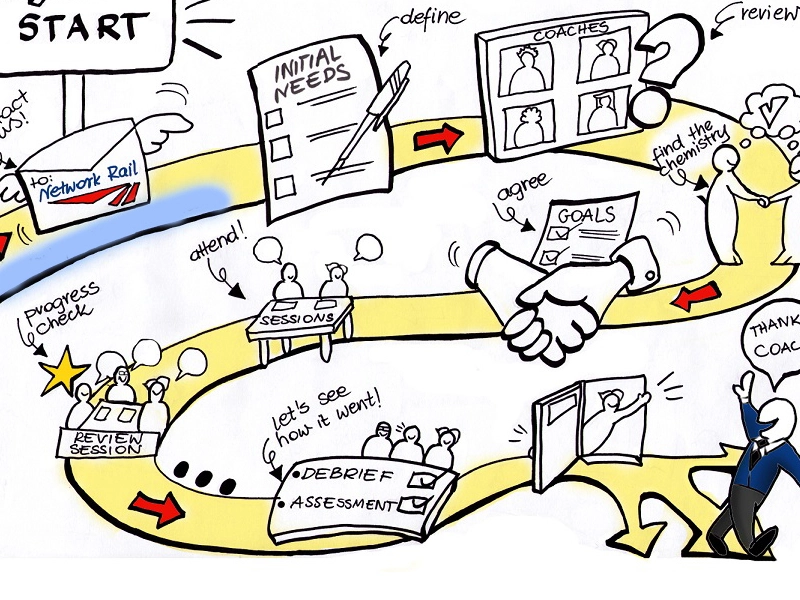
Image Source: Natalia Talkowska on Dribble
Mind maps let you see lots of information at once because they’re light on words and presented on one page. This makes them perfect for strategy outlines.
Break information down into manageable chunks, organize facts, and reduce overwhelm with a strategic mind map.
The mind maps example above was created to reduce a hefty 10-page word document down into something employees could take in at a glance. Little illustrations make information easier to take in, while arrows negate the need for explaining steps.
When creating a strategy mind map, start out with your target audience(s) and your goal. Once you have this information, you can start adding stages that lead toward achieving this. It may take a few attempts to refine it, but by the time you’re done, you should have something simple, clear, and, most importantly, easy to follow.
Project management mind map examples
Mind mapping is a great way to enhance project planning and show project stakeholders the full scope of work. Presenting your ideas like this doesn’t just make life easier for you and your clients — it could be the thing that sets you apart from your competitors.

Image Source: Blake Howard on Dribble
The example above groups different types of users into various subcategories, with specific attributes and priorities branching out from each subgroup.

Adding color to your branched mind map, like in the example above, will make information even easier to process.
Pro tip: Use different shapes for different layers of information. For example, the mind map above uses a circle for the core theme, then pointed-corner and rounded-corner rectangles for supporting concepts. Things like this help the viewer work out orders and priorities at a glance.
User experience mind maps
A mind map can also take the place of a flowchart when mapping out user journeys. The example below combines a user persona with examples of how they might flow through a car-selling app.
As a designer or marketer, you’re more likely to need to present information in an exciting, creative way — and UX mind maps are a great way to do this. Make yours eye-catching with colors, diagrams, sketches, and other visuals.
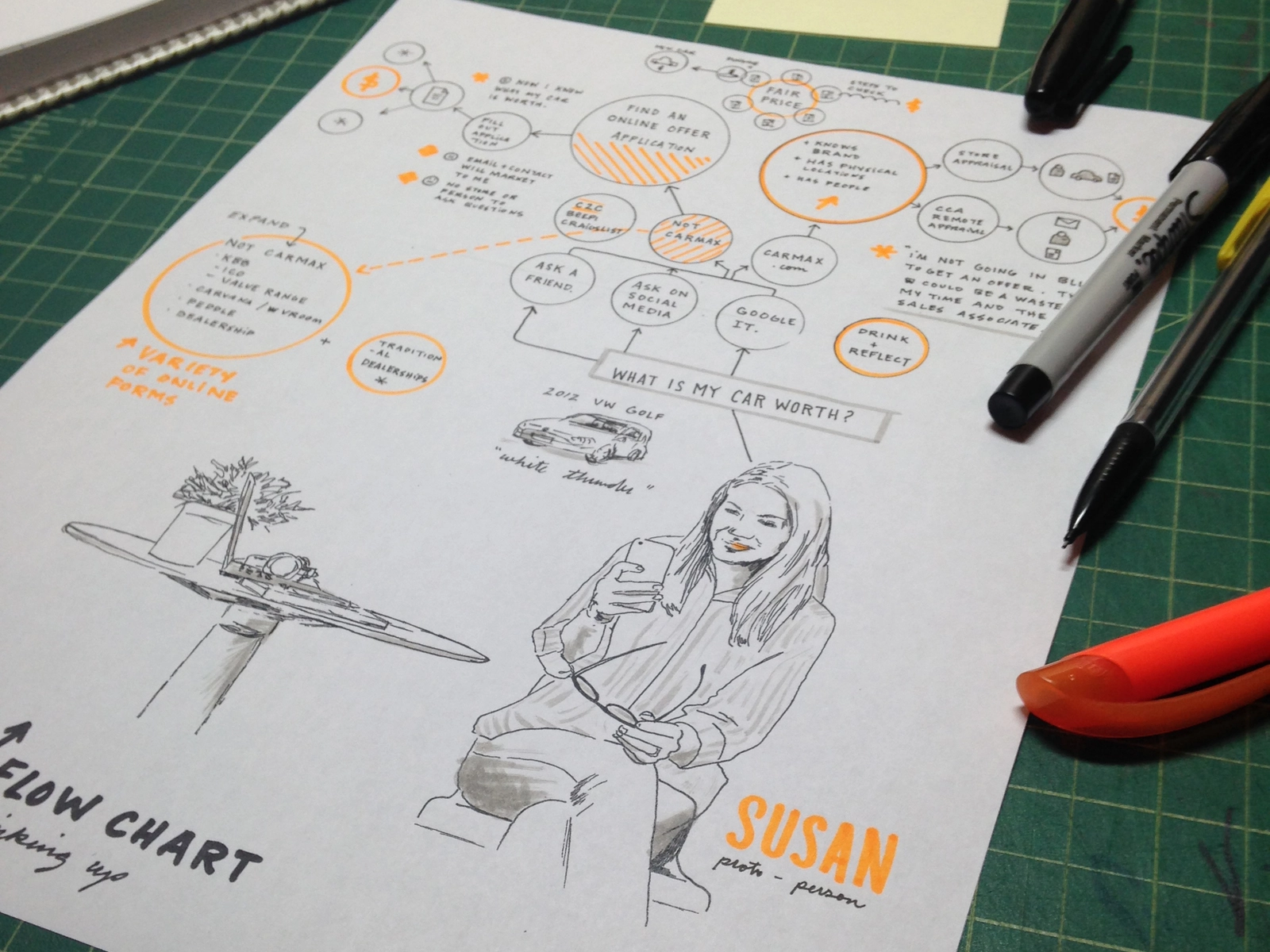
Image Source: Larry Thacker on Dribble
UX mind maps can also be used to show website navigation, with page structure sprouting off from each core page.
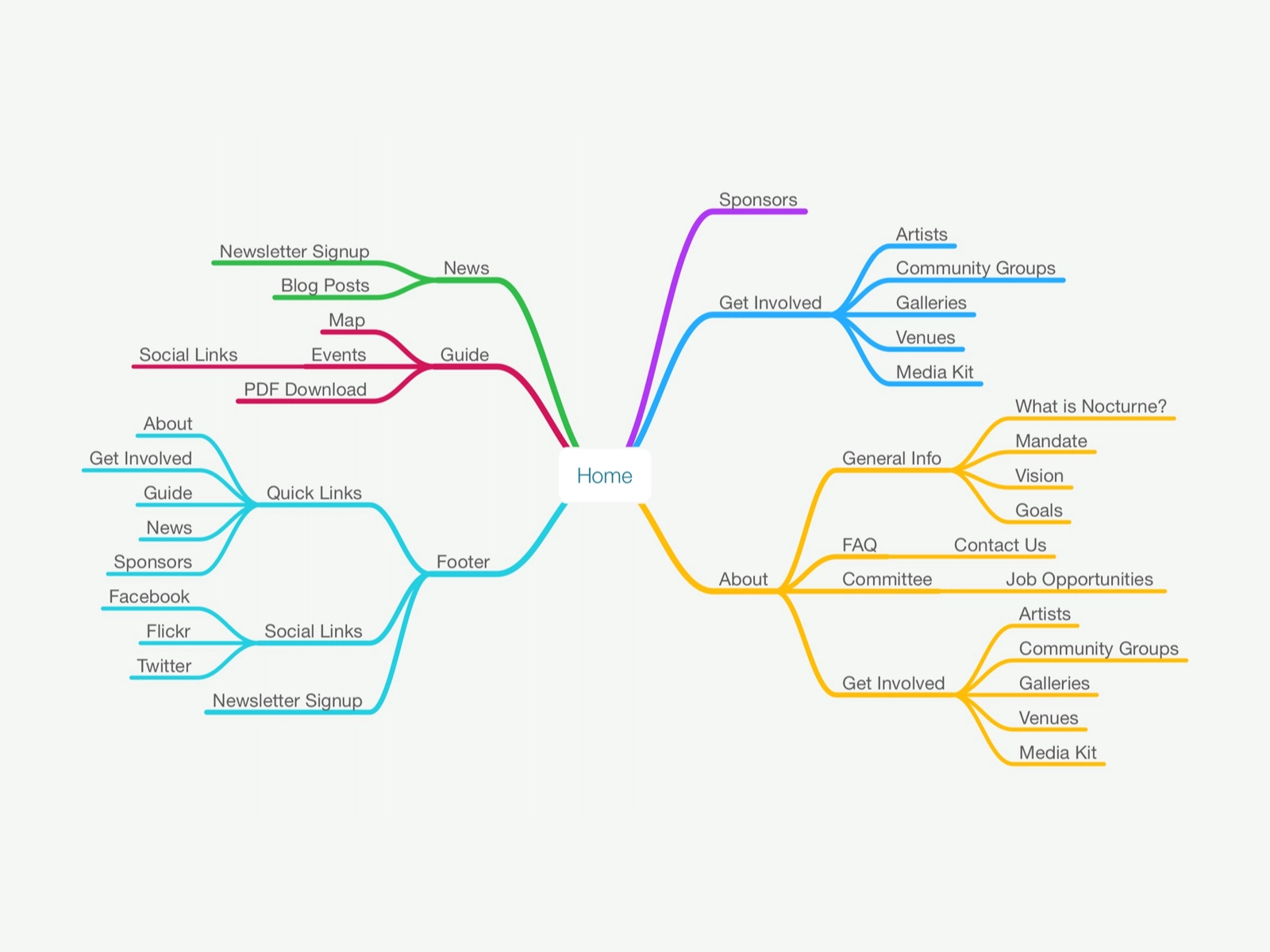
Image Source: Nicky Lee Woodman on Dribble
You can show how products will be grouped, where landing pages fall within the user journey, how blog posts connect via internal links, etc. This makes it easier for clients to get a feel for a website before it’s made — while helping designers spot potential dead-ends or missed opportunities.
Pro tip: Add mind maps to presentations or reports as a visual way to explain new concepts or break down complex information.
Brainstorming mind map
The cornerstone of a good brainstorming session? Quantity over quality.
Brainstorming is about exploring as many possibilities as possible, so encourage participants to remove their filters and just throw as many ideas out there as possible. No commenting on whether they’re good or bad — just get them down.

Image Source: Noah Kareus on Dribble
This example isn’t particularly clear, but its scope is big. It’s a great first start. Once you have this, you can start narrowing down your thoughts into something more refined.
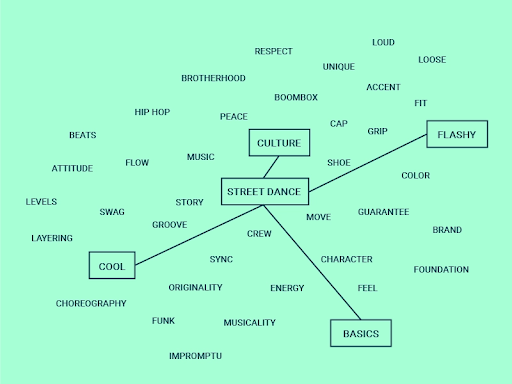
Image Source: Bharat Apat on Dribble
The image above shows how you can do this using diagramming software. Get your core idea down, followed by a few key themes — then add words on the page as they come. No need to worry about putting them all in boxes or wasting time with formatting. It’s quick and easy, and best of all — everyone on the team can work on it together, even if they’re not in the same room.
This is especially useful now as there’s an increased call for remote ways of working. In fact, opening up the discussion to a wider group of people can help small teams break out of repetitive ways of thinking and bring fresh ideas to the table.
Pro tip: To get your collaborative brainstorm session rolling, make sure you ask the right questions. Add the key question to the center of your template (or add multiple questions around your core theme), then work from there. Here are three to get you started:
- What’s the biggest avoidable hassle our customers put up with?
- Who uses our product in ways we hadn’t anticipated?
- What complexity do we deal with daily that could be eliminated?

Image Source: Zhart on Dribble
It’s normal for your brainstorming mind map to go through several iterations. Break ideas down into further ideas and courses of action using shapes, bullet points, or colors, like in the example above.
Colors aren’t just there to make your design look pretty (although looking nice is never a bad thing). They also help make the information in your chart easier to read. Use color to organize data or highlight specific areas.
Pro tip: On the lookout for cool color combinations? Try a tool like Coolors or ColourLOVERS to try out different pallet sets.
Enhancing note-taking with mind maps
From workshops to lectures and meetings, taking notes can help you recall important information later on. You could write things down neatly in a notebook — but going back over lines upon lines of handwriting later on isn’t an enticing prospect.
You’ll recall information better if you take notes as a mind map instead. This is because as you work, you’ll link ideas, creating connections — which makes recollection easier. With linear notes, there’s no way to connect each one back to the original topic.
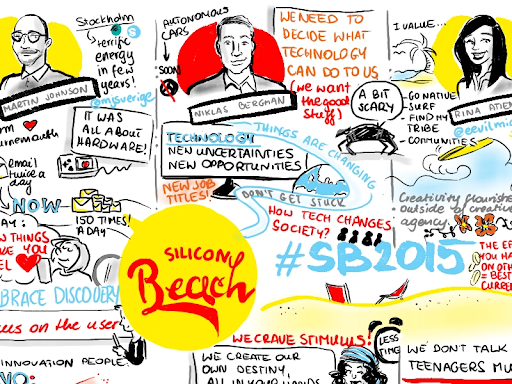
Image Source: Natalia Talkowska on Dribble
The above example starts with the name of the event, with facts and notes spanning out across the page. Colors and images draw the eye and make the resulting mind map a pleasure to look at.
Concept mapping
Concept maps often pop up in education because they’re a great way to help students link knowledge and understand the central concept they’re studying.
Not just limited to the classroom, they can be used in business to help employees and stakeholders get to grips with complex ideas or processes.
They’re effective because they let you see the whole picture at once, as well as how each element is connected.
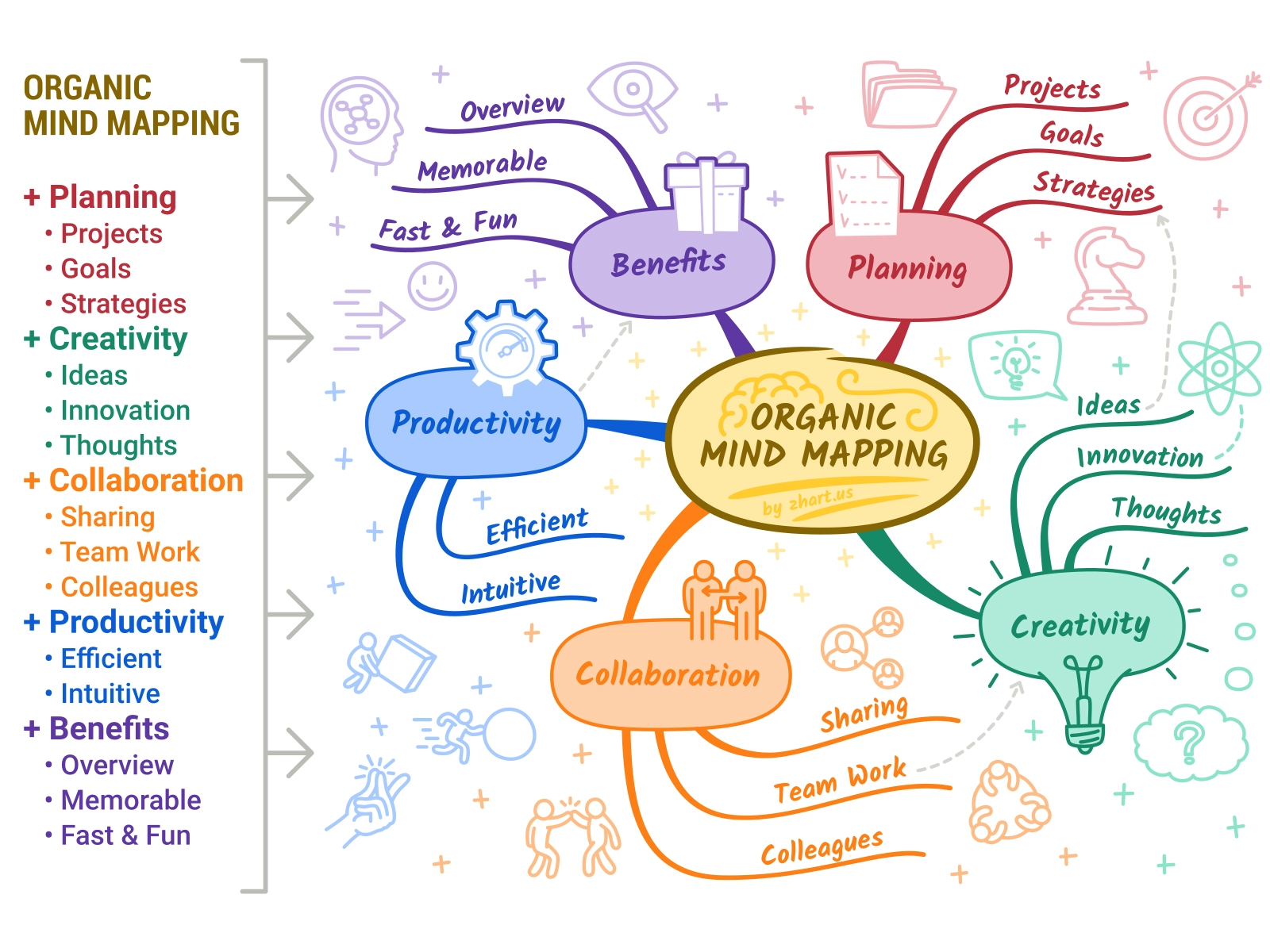
Image Source: Zhart on Dribble
A concept mind map can be as simple as words scribbled down on paper or on a whiteboard — as seen in the example below.
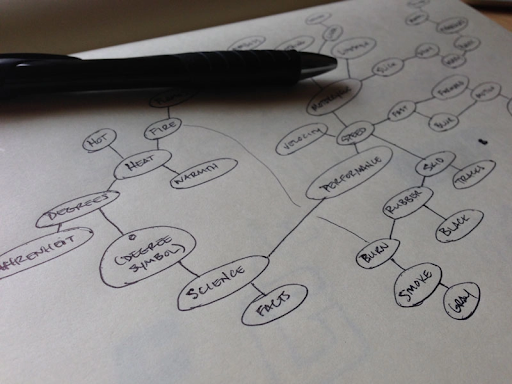
Image Source: Angie Hererra on Dribble
People think better visually, so using mind map diagrams is almost always a better way to record and present information. A concept mind map is the best way to show connections between ideas and generate new ideas based on existing points. Linking ideas like this helps with recall and prevents your reader from feeling lost.

Image Source: Tyler Wain on Dribble
A concept mind map could have an image as its central theme, with words or subsequent diagrams branching out from there. In the example above, the creator has honed in on specific parts of the bike, creating a macro-like focus on specific areas. This enables both a top-level look and a detailed look simultaneously.
Choosing a simple mind map template
There are lots of ways to create a mind map — from whiteboard scribbles to colorful notes with pen and paper. Just start with a central bubble, then add ideas in subsequent bubbles connected with lines.
While pen and paper is great for lectures, meetings, and classroom brainstorming sessions, as a mind mapping process, it does have downsides. You might run out of paper or space, hand-drawn diagrams aren’t easy to share with those not in the room, you can’t rearrange ideas, and they tend to look a bit messy. For these reasons, a mind-mapping tool might be the better option.
Rather than creating the thing from scratch and fiddling around with formatting boxes and circles, you can just choose your mind map template, and then populate it in a few clicks.
When using a mind map template, there are a few things you should decide before you get started.
- Your color scheme
- Which shapes you’ll use (if any)
- The layout
- Supporting visuals
- How in-depth you need to go
- What information do you need to include so your audience can understand it
Ultimately, your choices will depend on who your audience is and the purpose of your map. Most importantly, think about what your core question should be and who your audience is. Once you have those, you’re ready to start adding ideas.
How to create a mind map using Cacoo
Cacoo, our own mind map software, is really easy to use. Here’s how:
- Choose a mind map template that aligns with your project, goal, or brainstorming style.
- Choose the design you like
- You’ll be asked to create an account. You can access a limited version for free!
- Once logged in, you’ll be taken to the editor tool. It’s drag and drop, so you’ll pick it up in minutes.
- Click the text inside the bubbles to edit it.
- Click and drag to add shapes, text, or rearrange items — or delete those you don’t want
- Decorate your design with colors, images, and icons
- Share your creation with others and invite them to leave comments. The more feedback, the better!
![[Flowchart] Here’s what you should be reading right now: A Cacoo flowchart](https://cdn.nulab.com/learn-wp/app/uploads/2018/07/14210212/Screen-Shot-2018-07-26-at-3.27.33-PM.png)
![[Flowchart] Single? Married? Here’s how to spend Valentine’s Day](https://cdn.nulab.com/learn-wp/app/uploads/2020/02/14210832/Cacoo-Valentines-Day-Infographic-Blog.png)